
ai-edge-quantizer
AI Edge Quantizer: flexible post training quantization for LiteRT models.
Stars: 66
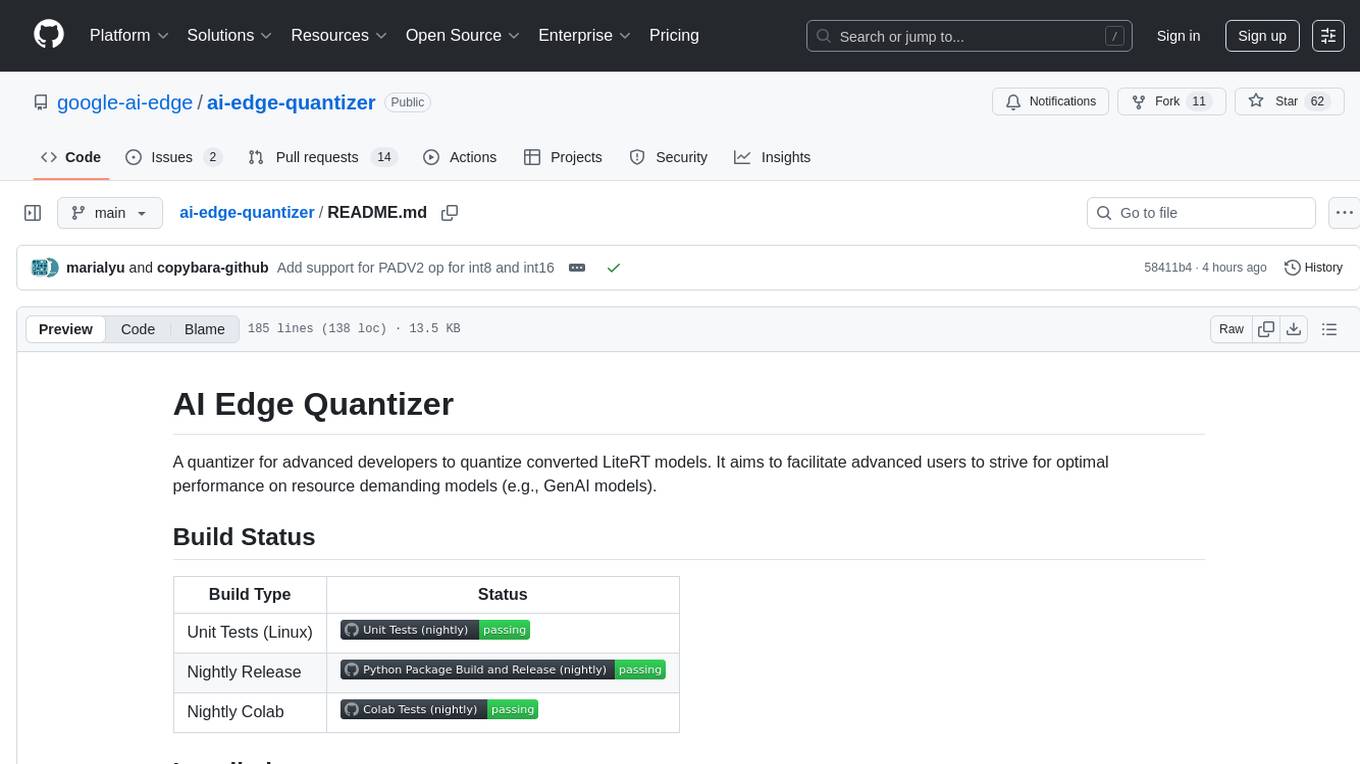
AI Edge Quantizer is a tool designed for advanced developers to quantize converted LiteRT models. It aims to optimize performance on resource-demanding models by providing quantization recipes for edge device deployment. The tool supports dynamic quantization, weight-only quantization, and static quantization methods, allowing users to customize the quantization process for different hardware deployments. Users can specify quantization recipes to apply to source models, resulting in quantized LiteRT models ready for deployment. The tool also includes advanced features such as selective quantization and mixed precision schemes for fine-tuning quantization recipes.
README:
A quantizer for advanced developers to quantize converted LiteRT models. It aims to facilitate advanced users to strive for optimal performance on resource demanding models (e.g., GenAI models).
| Build Type | Status |
|---|---|
| Unit Tests (Linux) | |
| Nightly Release | |
| Nightly Colab |
Nightly PyPi package:
pip install ai-edge-quantizer-nightlyThe quantizer requires two inputs:
- An unquantized source LiteRT model (with FP32 data type in the FlatBuffer format with
.tfliteextension) - A quantization recipe (details below)
and outputs a quantized LiteRT model that's ready for deployment on edge devices.
In a nutshell, the quantizer works according to the following steps:
- Instantiate a
Quantizerclass. This is the entry point to the quantizer's functionalities that the user accesses. - Load a desired quantization recipe (details in subsection).
- Quantize (and save) the model. This is where most of the quantizer's internal logic works.
qt = quantizer.Quantizer("path/to/input/tflite")
qt.load_quantization_recipe(recipe.dynamic_wi8_afp32())
qt.quantize().export_model("/path/to/output/tflite")Please see the getting started colab for the simplest quick start guide on those 3 steps, and the selective quantization colab with more details on advanced features.
Please refer to the LiteRT documentation for ways to generate LiteRT models from Jax, PyTorch and TensorFlow. The input source model should be an FP32 (unquantized) model in the FlatBuffer format with .tflite extension.
The user needs to specify a quantization recipe using AI Edge Quantizer's API to apply to the source model. The quantization recipe encodes all information on how a model is to be quantized, such as number of bits, data type, symmetry, scope name, etc.
Essentially, a quantization recipe is defined as a collection of commands of the following type:
“Apply Quantization Algorithm X on Operator Y under Scope Z with ConfigN”.
For example:
"Uniformly quantize the FullyConnected op under scope 'dense1/' with INT8 symmetric with Dynamic Quantization".
All the unspecified ops will be kept as FP32 (unquantized). The scope of an operator in TFLite is defined as the output tensor name of the op, which preserves the hierarchical model information from the source model (e.g., scope in TF). The best way to obtain scope name is by visualizing the model with Model Explorer.
Currently, there are three ways to quantize an operator:
-
dynamic quantization (recommended): weights are quantized while activations remain in a float format and are not processed by AI Edge Quantizer (AEQ). The runtime kernel handles the on-the-fly quantization of these activations, as identified by
compute_precision=integerandexplicit_dequantize=False.- Pros: reduced model size and memory usage. Latency improvement due to integer computation. No sample data requirement (calibration).
- Cons: on-the-fly quantization of activation tensors can affect model quality. Not supported in all hardware (e.g., some GPU and NPU).
-
weight only quantization: only model weights are quantized, not activations. The actual operation (op) computation remains in float. The quantized weight is explicitly dequantized before being fed into the op, by inserting a dequantize op between the quantized weight and the consuming op. To enable this,
compute_precisionwill be set tofloatandexplicit_dequantizetoTrue.- Pros: reduced model size and memory usage. No sample data requirement (calibration). Usually has the best model quality.
- Cons: no latency benefit (may be worse) due to float computation with explicit dequantization.
-
static quantization: both weights and activations are quantized. This requires a calibration phase to estimate quantization parameters of runtime tensors (activations).
- Pros: reduced model size, memory usage, and latency.
- Cons: requires sample data for calibration. Imposing static quantization parameters (derived from calibration) on runtime tensors can compromise quality.
Generally, we recommend dynamic quantization for CPU/GPU deployment and static quantization for NPU deployment.
We include commonly used recipes in recipe.py. This is demonstrated in the getting started colab example. Advanced users can build their own recipe through the quantizer API.
Please refer to the LiteRT deployment documentation for ways to deploy a quantized LiteRT model.
There are many ways the user can configure and customize the quantization recipe beyond using a template in recipe.py. For example, the user can configure the recipe to achieve these features:
- Selective quantization (exclude selected ops from being quantized)
- Flexible mixed scheme quantization (mixture of different precision, compute precision, scope, op, config, etc)
- 4-bit weight quantization
The selective quantization colab shows some of these more advanced features.
For specifics of the recipe schema, please refer to the OpQuantizationRecipe in [recipe_manager.py].
For advanced usage involving mixed quantization, the following API may be useful:
- Use
Quantizer:load_quantization_recipe()in quantizer.py to load a custom recipe. - Use
Quantizer:update_quantization_recipe()in quantizer.py to extend or override specific parts of the recipe.
The table below outlines the allowed configurations for available recipes.
| Config | DYNAMIC_WI8_AFP32 | DYNAMIC_WI4_AFP32 | STATIC_WI8_AI16 | STATIC_WI4_AI16 | STATIC_WI8_AI8 | STATIC_WI4_AI8 | WEIGHTONLY_WI8_AFP32 | WEIGHTONLY_WI4_AFP32 | |
| activation | num_bits | None | None | 16 | 16 | 8 | 8 | None | None |
| symmetric | None | None | TRUE | TRUE | [TRUE, FALSE] | [TRUE, FALSE] | None | None | |
| granularity | None | None | TENSORWISE | TENSORWISE | TENSORWISE | TENSORWISE | None | None | |
| dtype | None | None | INT | INT | INT | INT | None | None | |
| weight | num_bits | 8 | 4 | 8 | 4 | 8 | 4 | 8 | 4 |
| symmetric | TRUE | TRUE | TRUE | TRUE | TRUE | TRUE | [TRUE, FALSE] | [TRUE, FALSE] | |
| granularity | [CHANNELWISE, TENSORWISE] | [CHANNELWISE, TENSORWISE] | [CHANNELWISE, TENSORWISE] | [CHANNELWISE, TENSORWISE] | [CHANNELWISE, TENSORWISE] | [CHANNELWISE, TENSORWISE] | [CHANNELWISE, TENSORWISE] | [CHANNELWISE, TENSORWISE] | |
| dtype | INT | INT | INT | INT | INT | INT | INT | INT | |
| explicit_dequantize | FALSE | FALSE | FALSE | FALSE | FALSE | FALSE | TRUE | TRUE | |
| compute_precision | INTEGER | INTEGER | INTEGER | INTEGER | INTEGER | INTEGER | FLOAT | FLOAT |
Operators Supporting Quantization
| Config | DYNAMIC_WI8_AFP32 | DYNAMIC_WI4_AFP32 | STATIC_WI8_AI16 | STATIC_WI4_AI16 | STATIC_WI8_AI8 | STATIC_WI4_AI8 | WEIGHTONLY_WI8_AFP32 | WEIGHTONLY_WI4_AFP32 |
| FULLY_CONNECTED | ✓ |
✓ |
✓ |
✓ |
✓ |
✓ |
✓ |
✓ |
| CONV_2D | ✓ |
✓ |
✓ |
✓ |
✓ |
✓ |
||
| BATCH_MATMUL | ✓ |
✓ |
✓ |
✓ |
||||
| EMBEDDING_LOOKUP | ✓ |
✓ |
✓ |
✓ |
✓ |
✓ |
||
| DEPTHWISE_CONV_2D | ✓ |
✓ |
✓ |
✓ |
||||
| AVERAGE_POOL_2D | ✓ |
✓ |
||||||
| RESHAPE | ✓ |
✓ |
||||||
| SOFTMAX | ✓ |
✓ |
||||||
| TANH | ✓ |
✓ |
||||||
| TRANSPOSE | ✓ |
✓ |
||||||
| GELU | ✓ |
✓ |
||||||
| ADD | ✓ |
✓ |
||||||
| CONV_2D_TRANSPOSE | ✓ |
✓ |
✓ |
|||||
| SUB | ✓ |
✓ |
||||||
| MUL | ✓ |
✓ |
||||||
| MEAN | ✓ |
✓ |
||||||
| RSQRT | ✓ |
✓ |
||||||
| CONCATENATION | ✓ |
✓ |
||||||
| STRIDED_SLICE | ✓ |
✓ |
||||||
| SPLIT | ✓ |
✓ |
||||||
| LOGISTIC | ✓ |
✓ |
||||||
| SLICE | ✓ |
✓ |
||||||
| SELECT | ✓ |
✓ |
||||||
| SELECT_V2 | ✓ |
✓ |
||||||
| SUM | ✓ |
✓ |
||||||
| PAD | ✓ |
✓ |
||||||
| PADV2 | ✓ |
✓ |
||||||
| SQUARED_DIFFERENCE | ✓ |
|||||||
| MAX_POOL_2D | ✓ |
✓ |
||||||
| RESIZE_BILINEAR | ✓ |
✓ |
||||||
| GATHER_ND | ✓ |
✓ |
||||||
| PACK | ✓ |
✓ |
||||||
| UNPACK | ✓ |
✓ |
||||||
| DIV | ✓ |
✓ |
||||||
| SQRT | ✓ |
✓ |
||||||
| GATHER | ✓ |
✓ |
||||||
| HARD_SWISH | ✓ |
|||||||
| MAXIMUM | ✓ |
✓ |
||||||
| REDUCE_MIN | ✓ |
✓ |
||||||
| EQUAL | ✓ |
✓ |
||||||
| NOT_EQUAL | ✓ |
✓ |
For Tasks:
Click tags to check more tools for each tasksFor Jobs:
Alternative AI tools for ai-edge-quantizer
Similar Open Source Tools

ai-edge-quantizer
AI Edge Quantizer is a tool designed for advanced developers to quantize converted LiteRT models. It aims to optimize performance on resource-demanding models by providing quantization recipes for edge device deployment. The tool supports dynamic quantization, weight-only quantization, and static quantization methods, allowing users to customize the quantization process for different hardware deployments. Users can specify quantization recipes to apply to source models, resulting in quantized LiteRT models ready for deployment. The tool also includes advanced features such as selective quantization and mixed precision schemes for fine-tuning quantization recipes.
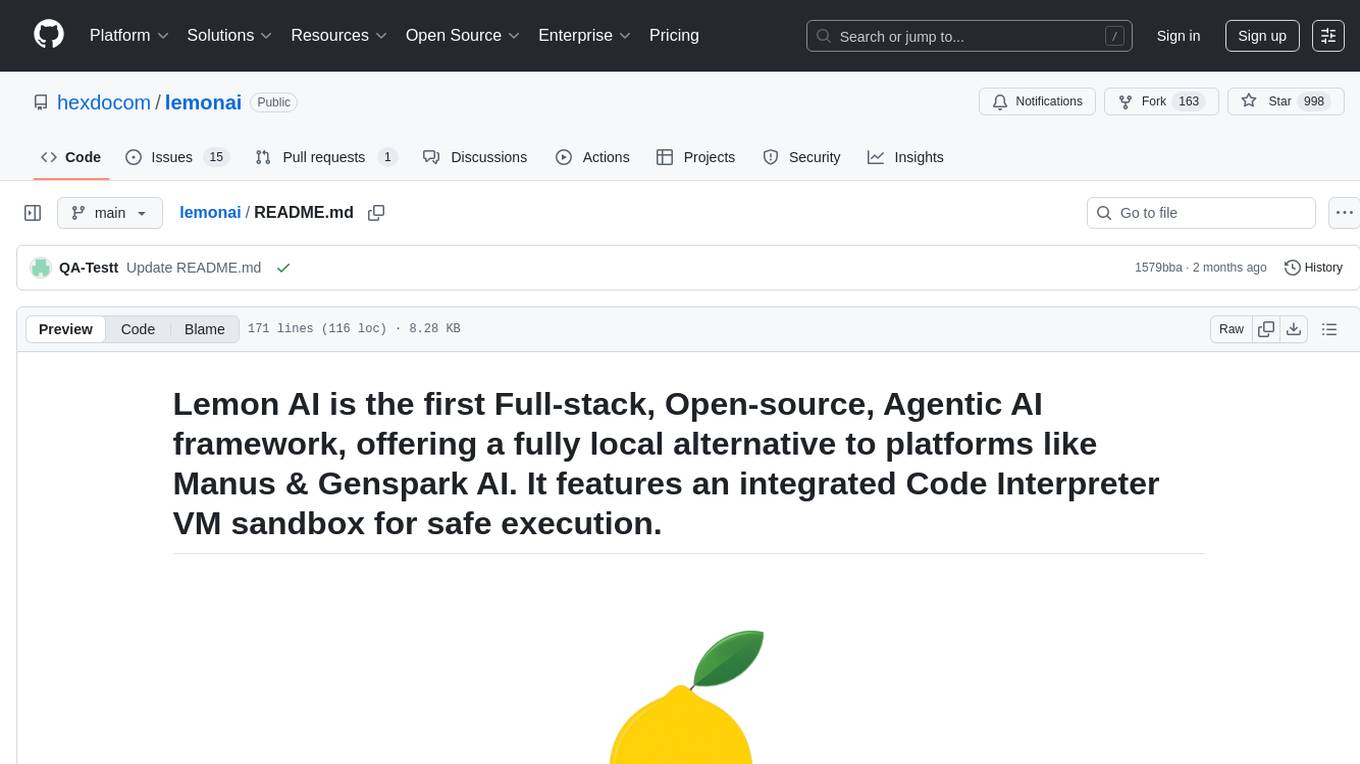
lemonai
LemonAI is a versatile machine learning library designed to simplify the process of building and deploying AI models. It provides a wide range of tools and algorithms for data preprocessing, model training, and evaluation. With LemonAI, users can easily experiment with different machine learning techniques and optimize their models for various tasks. The library is well-documented and beginner-friendly, making it suitable for both novice and experienced data scientists. LemonAI aims to streamline the development of AI applications and empower users to create innovative solutions using state-of-the-art machine learning methods.
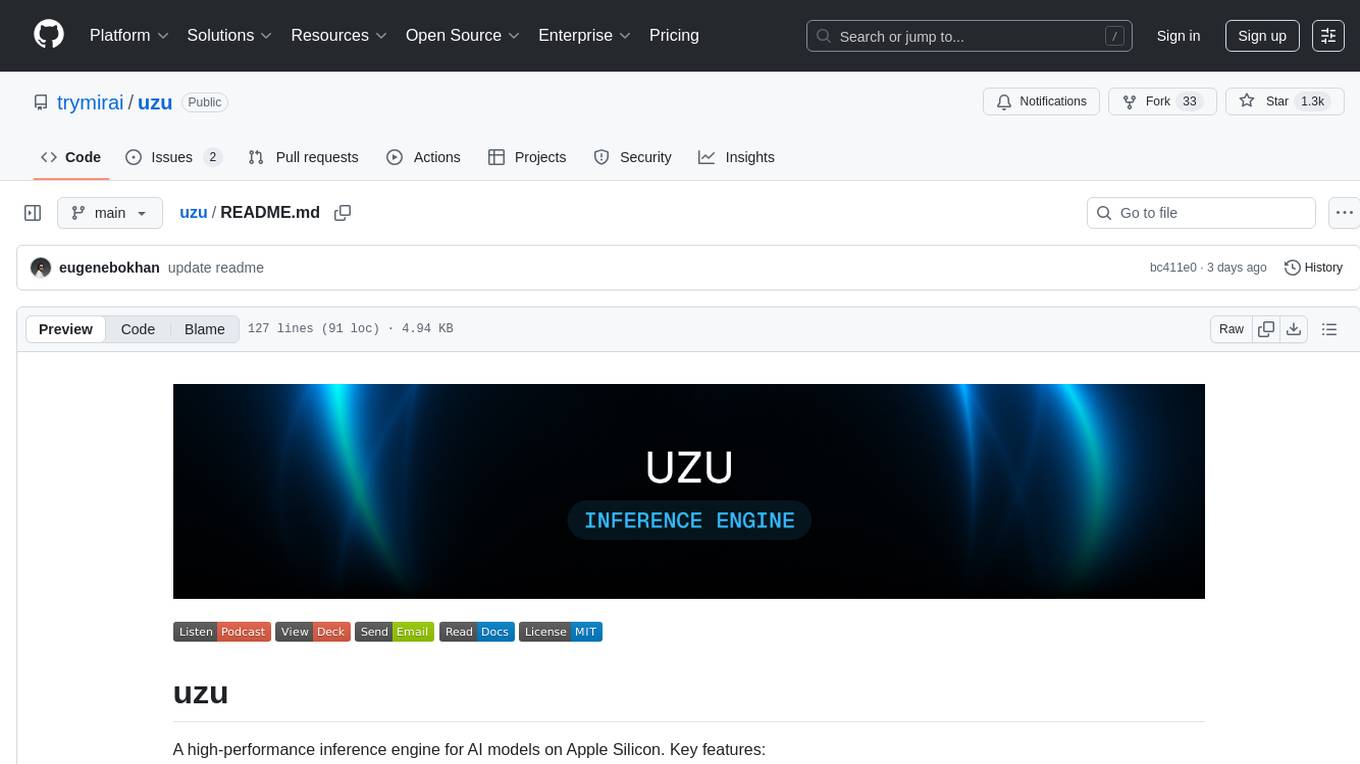
uzu
uzu is a high-performance inference engine for AI models on Apple Silicon. It features a simple, high-level API, hybrid architecture for GPU kernel computation, unified model configurations, traceable computations, and utilizes unified memory on Apple devices. The tool provides a CLI mode for running models, supports its own model format, and offers prebuilt Swift and TypeScript frameworks for bindings. Users can quickly start by adding the uzu dependency to their Cargo.toml and creating an inference Session with a specific model and configuration. Performance benchmarks show metrics for various models on Apple M2, highlighting the tokens/s speed for each model compared to llama.cpp with bf16/f16 precision.
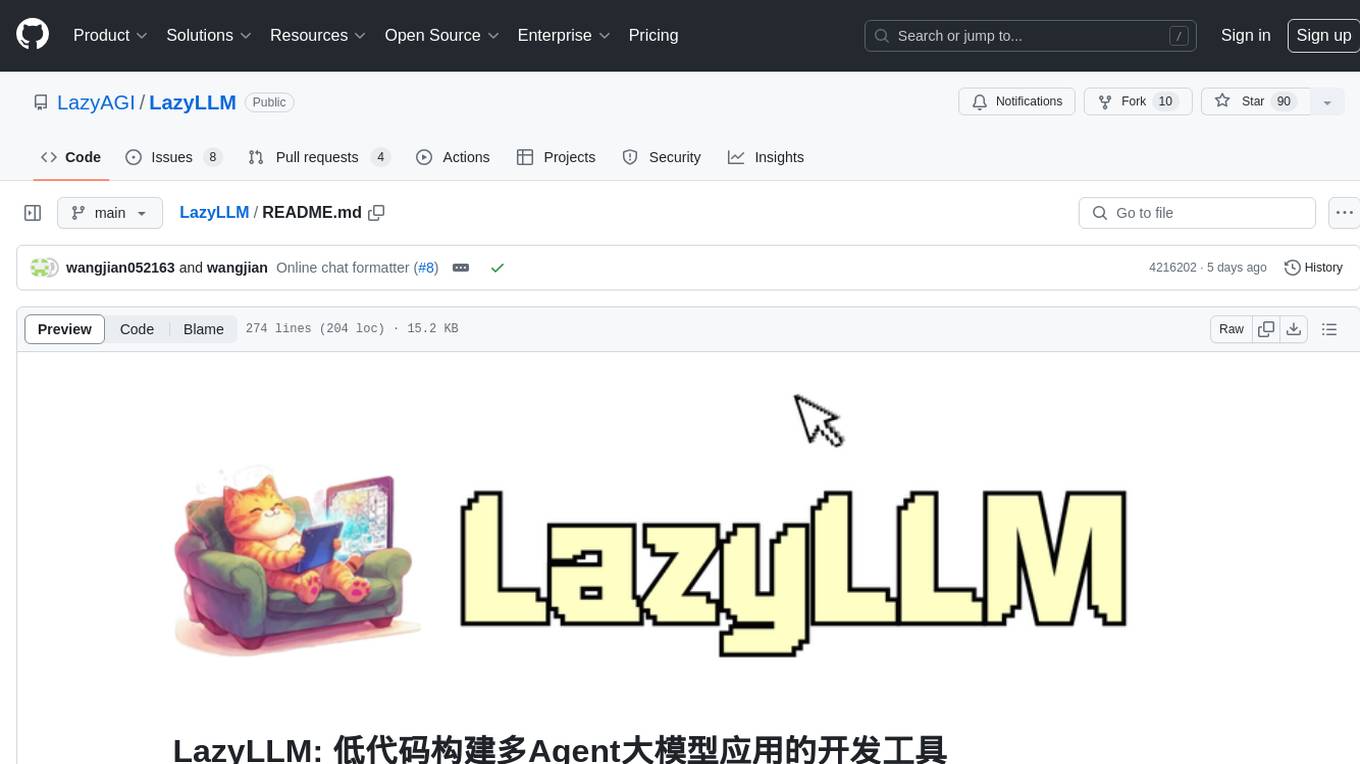
LazyLLM
LazyLLM is a low-code development tool for building complex AI applications with multiple agents. It assists developers in building AI applications at a low cost and continuously optimizing their performance. The tool provides a convenient workflow for application development and offers standard processes and tools for various stages of application development. Users can quickly prototype applications with LazyLLM, analyze bad cases with scenario task data, and iteratively optimize key components to enhance the overall application performance. LazyLLM aims to simplify the AI application development process and provide flexibility for both beginners and experts to create high-quality applications.
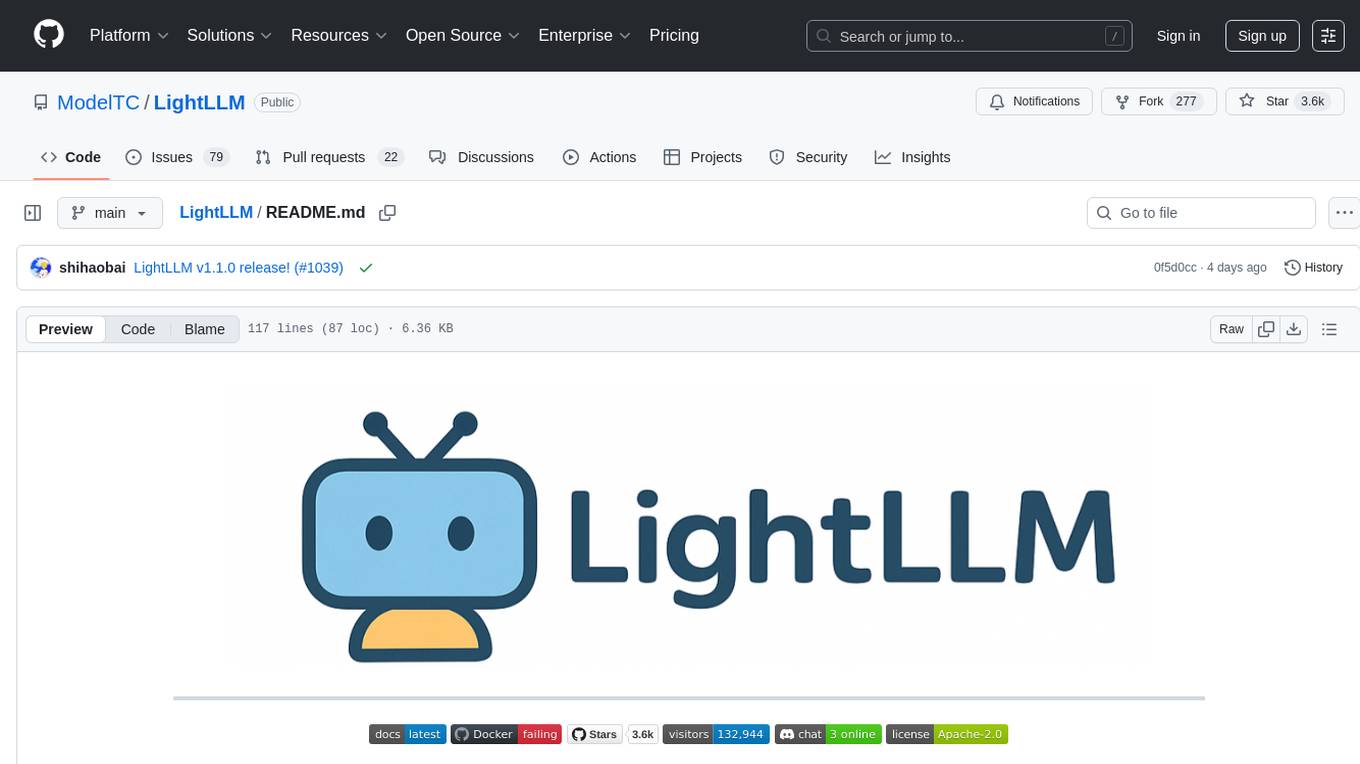
LightLLM
LightLLM is a lightweight library for linear and logistic regression models. It provides a simple and efficient way to train and deploy machine learning models for regression tasks. The library is designed to be easy to use and integrate into existing projects, making it suitable for both beginners and experienced data scientists. With LightLLM, users can quickly build and evaluate regression models using a variety of algorithms and hyperparameters. The library also supports feature engineering and model interpretation, allowing users to gain insights from their data and make informed decisions based on the model predictions.
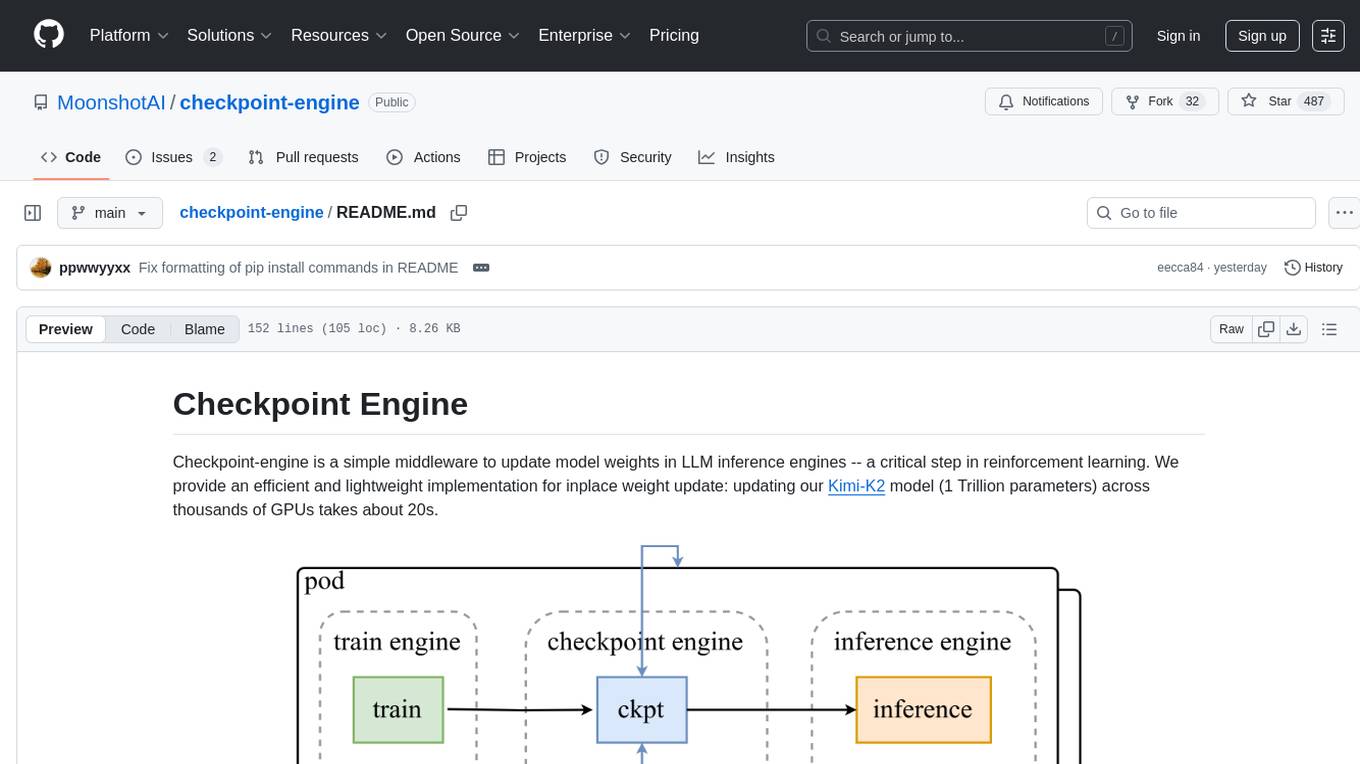
checkpoint-engine
Checkpoint-engine is a middleware tool designed for updating model weights in LLM inference engines efficiently. It provides implementations for both Broadcast and P2P weight update methods, orchestrating the transfer process and controlling the inference engine through ZeroMQ socket. The tool optimizes weight broadcast by arranging data transfer into stages and organizing transfers into a pipeline for performance. It supports flexible installation options and is tested with various models and device setups. Checkpoint-engine also allows reusing weights from existing instances and provides a patch for FP8 quantization in vLLM.
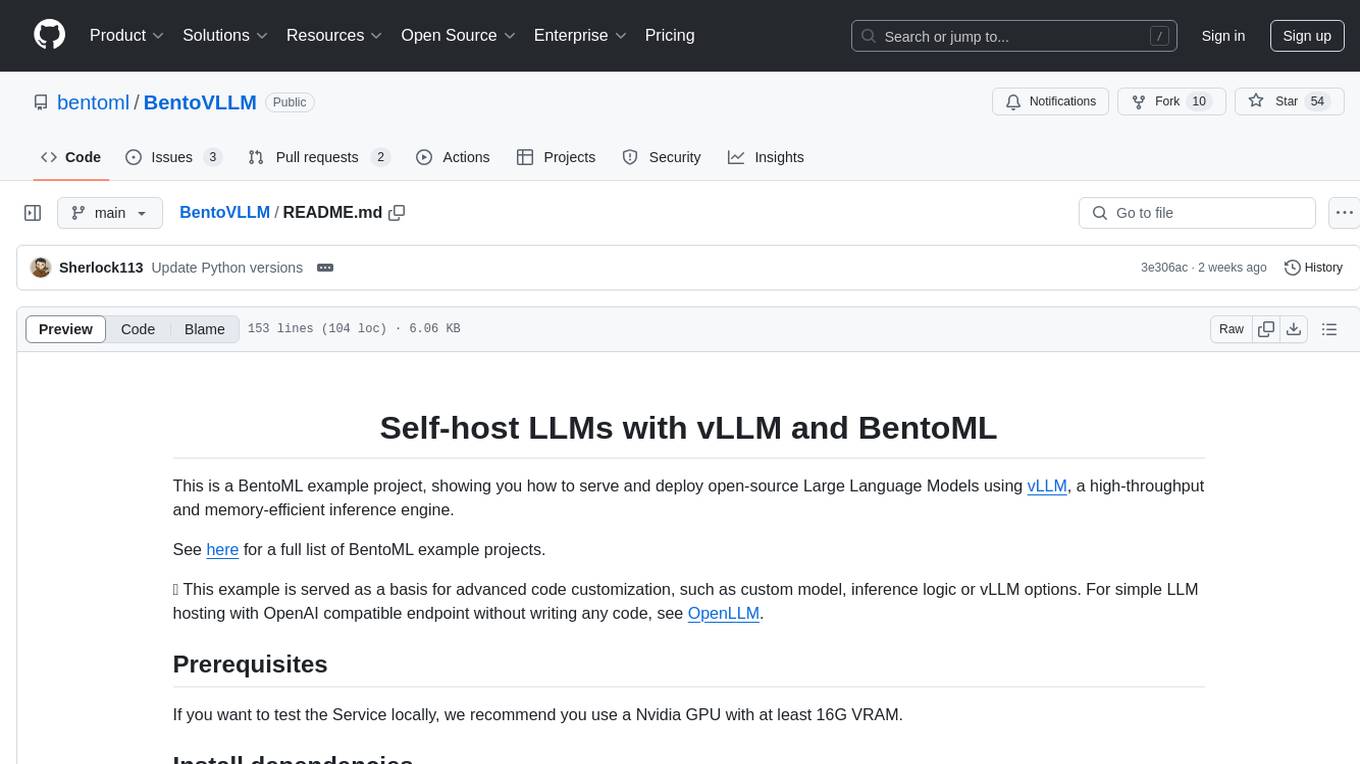
BentoVLLM
BentoVLLM is an example project demonstrating how to serve and deploy open-source Large Language Models using vLLM, a high-throughput and memory-efficient inference engine. It provides a basis for advanced code customization, such as custom models, inference logic, or vLLM options. The project allows for simple LLM hosting with OpenAI compatible endpoints without the need to write any code. Users can interact with the server using Swagger UI or other methods, and the service can be deployed to BentoCloud for better management and scalability. Additionally, the repository includes integration examples for different LLM models and tools.
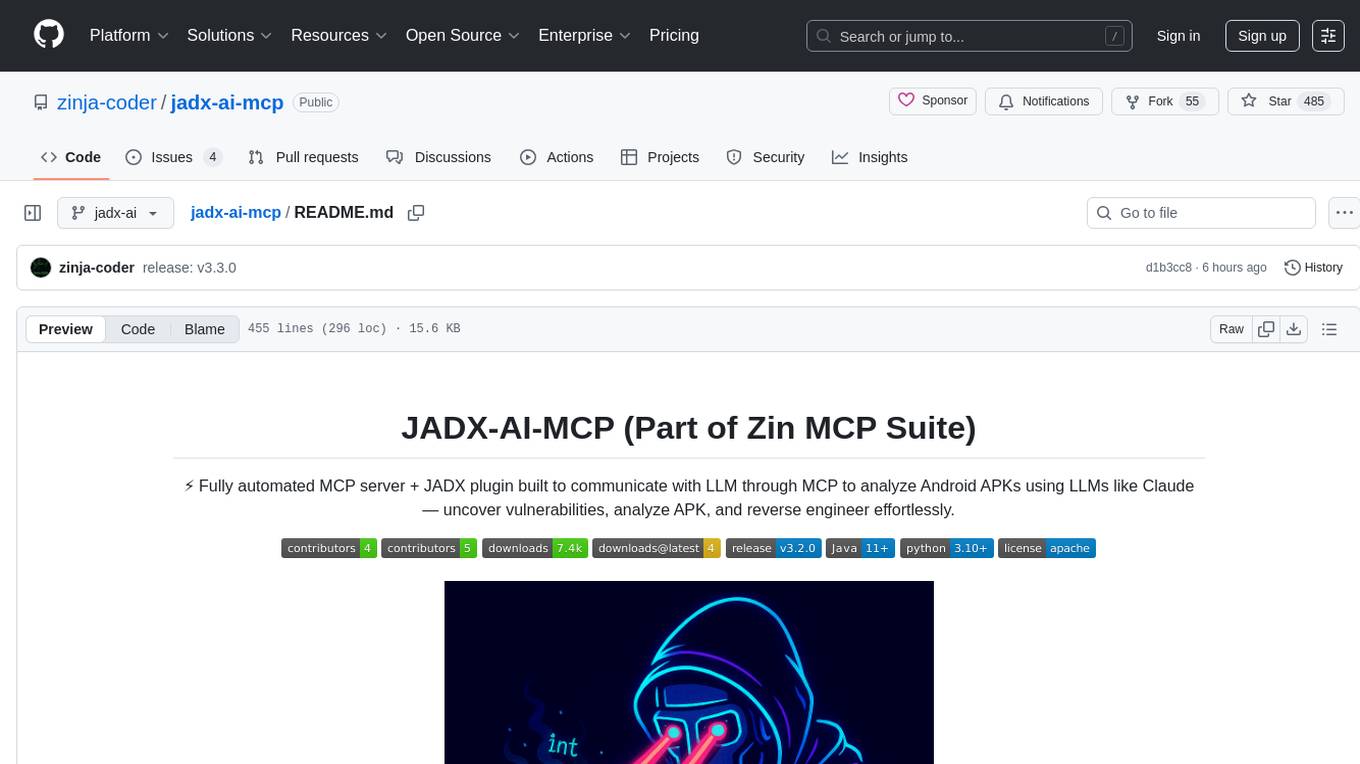
jadx-ai-mcp
JADX-AI-MCP is a plugin for the JADX decompiler that integrates with Model Context Protocol (MCP) to provide live reverse engineering support with LLMs like Claude. It allows for quick analysis, vulnerability detection, and AI code modification, all in real time. The tool combines JADX-AI-MCP and JADX MCP SERVER to analyze Android APKs effortlessly. It offers various prompts for code understanding, vulnerability detection, reverse engineering helpers, static analysis, AI code modification, and documentation. The tool is part of the Zin MCP Suite and aims to connect all android reverse engineering and APK modification tools with a single MCP server for easy reverse engineering of APK files.
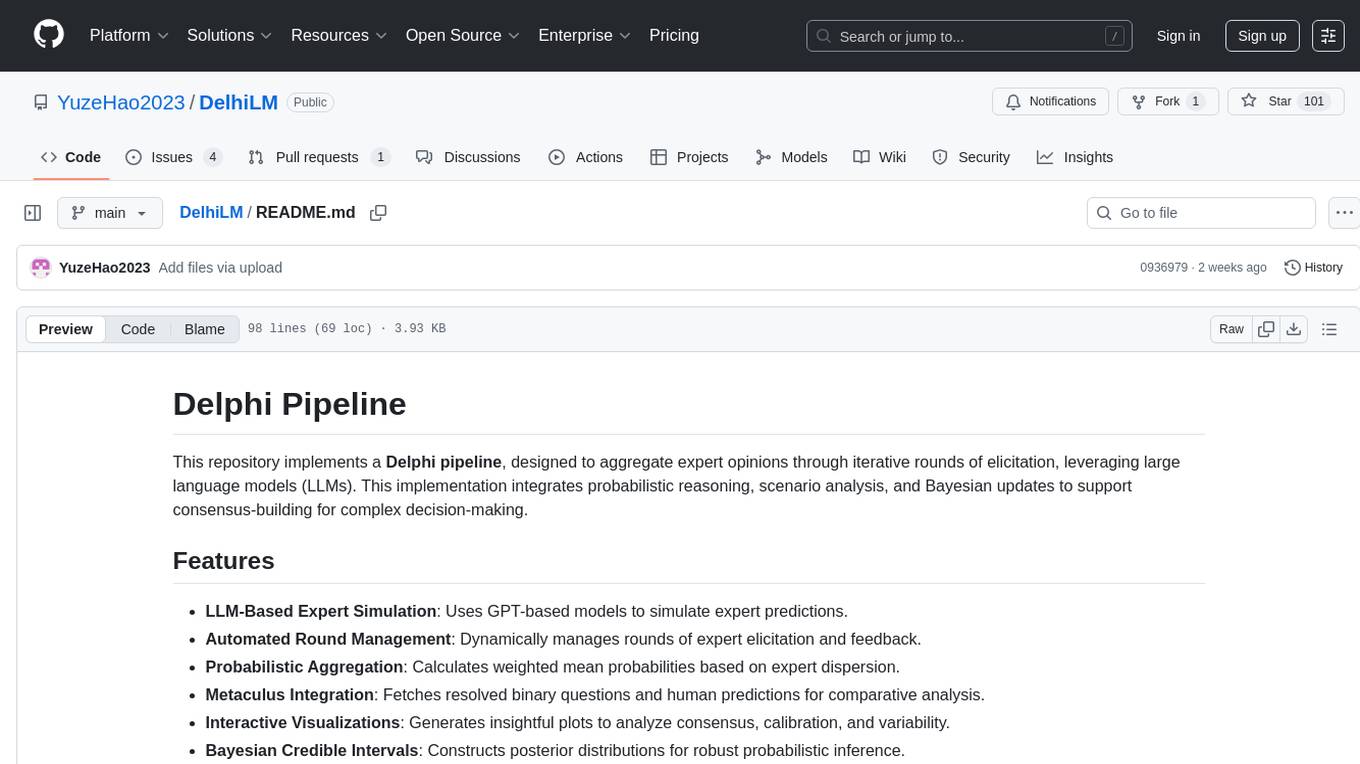
DelhiLM
DelhiLM is a natural language processing tool for building and training language models. It provides a user-friendly interface for text processing tasks such as tokenization, lemmatization, and language model training. With DelhiLM, users can easily preprocess text data and train custom language models for various NLP applications. The tool supports different languages and allows for fine-tuning pre-trained models to suit specific needs. DelhiLM is designed to be flexible, efficient, and easy to use for both beginners and experienced NLP practitioners.
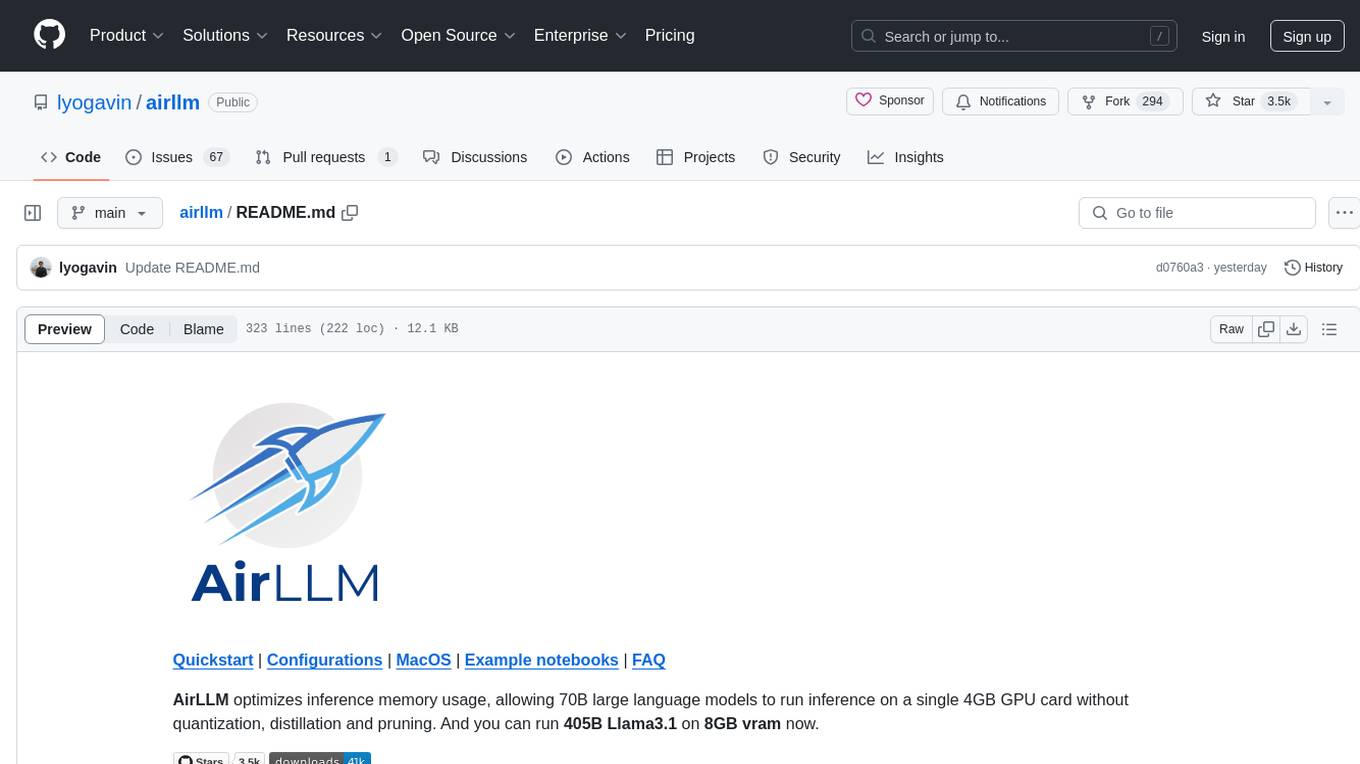
airllm
AirLLM is a tool that optimizes inference memory usage, enabling large language models to run on low-end GPUs without quantization, distillation, or pruning. It supports models like Llama3.1 on 8GB VRAM. The tool offers model compression for up to 3x inference speedup with minimal accuracy loss. Users can specify compression levels, profiling modes, and other configurations when initializing models. AirLLM also supports prefetching and disk space management. It provides examples and notebooks for easy implementation and usage.
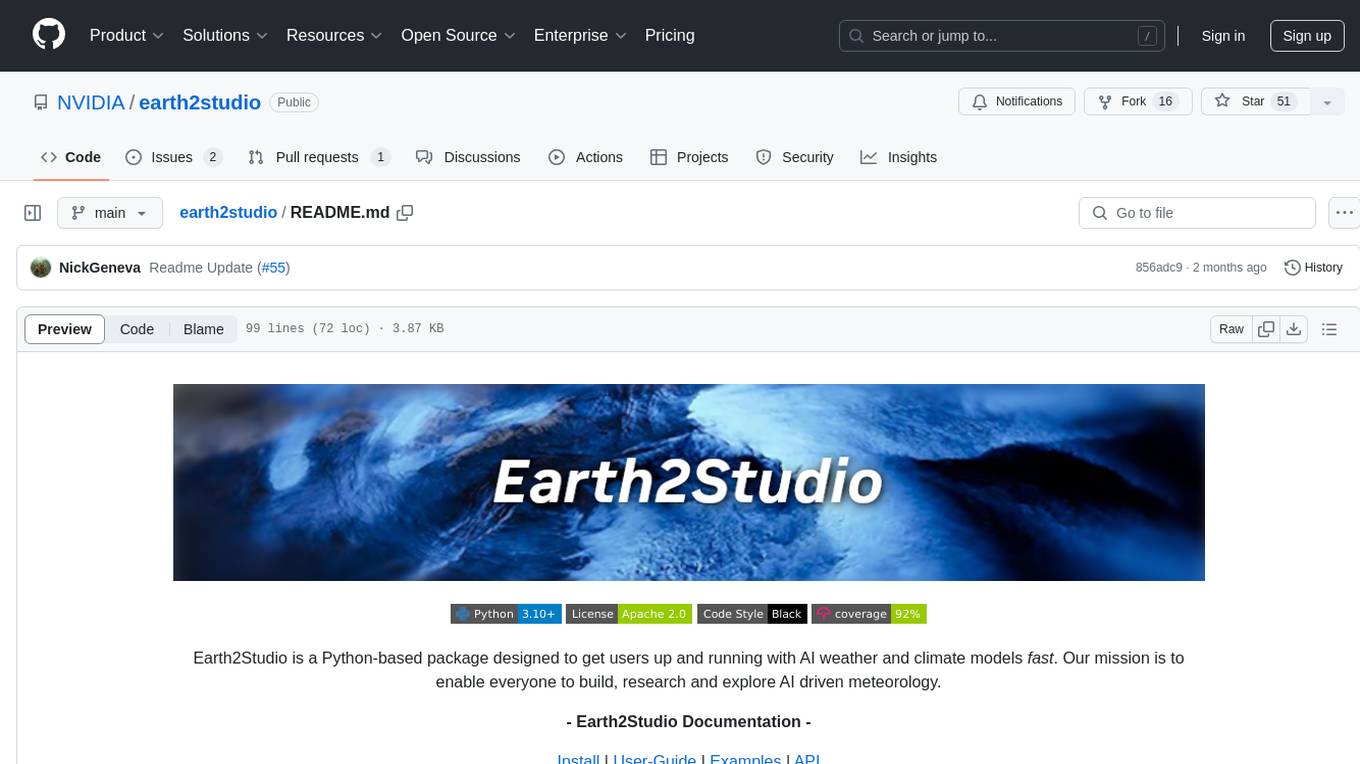
earth2studio
Earth2Studio is a Python-based package designed to enable users to quickly get started with AI weather and climate models. It provides access to pre-trained models, diagnostic tools, data sources, IO utilities, perturbation methods, and sample workflows for building custom weather prediction workflows. The package aims to empower users to explore AI-driven meteorology through modular components and seamless integration with other Nvidia packages like Modulus.
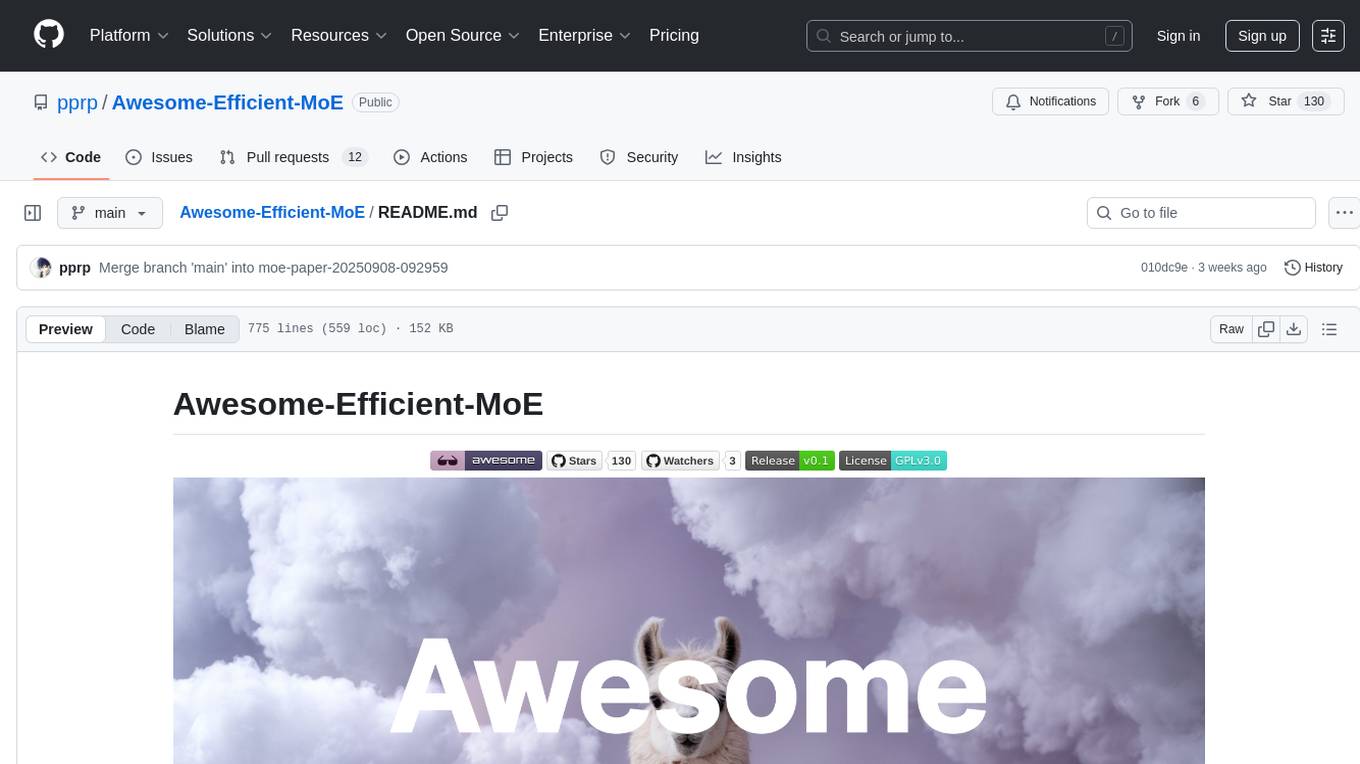
Awesome-Efficient-MoE
Awesome Efficient MoE is a GitHub repository that provides an implementation of Mixture of Experts (MoE) models for efficient deep learning. The repository includes code for training and using MoE models, which are neural network architectures that combine multiple expert networks to improve performance on complex tasks. MoE models are particularly useful for handling diverse data distributions and capturing complex patterns in data. The implementation in this repository is designed to be efficient and scalable, making it suitable for training large-scale MoE models on modern hardware. The code is well-documented and easy to use, making it accessible for researchers and practitioners interested in leveraging MoE models for their deep learning projects.
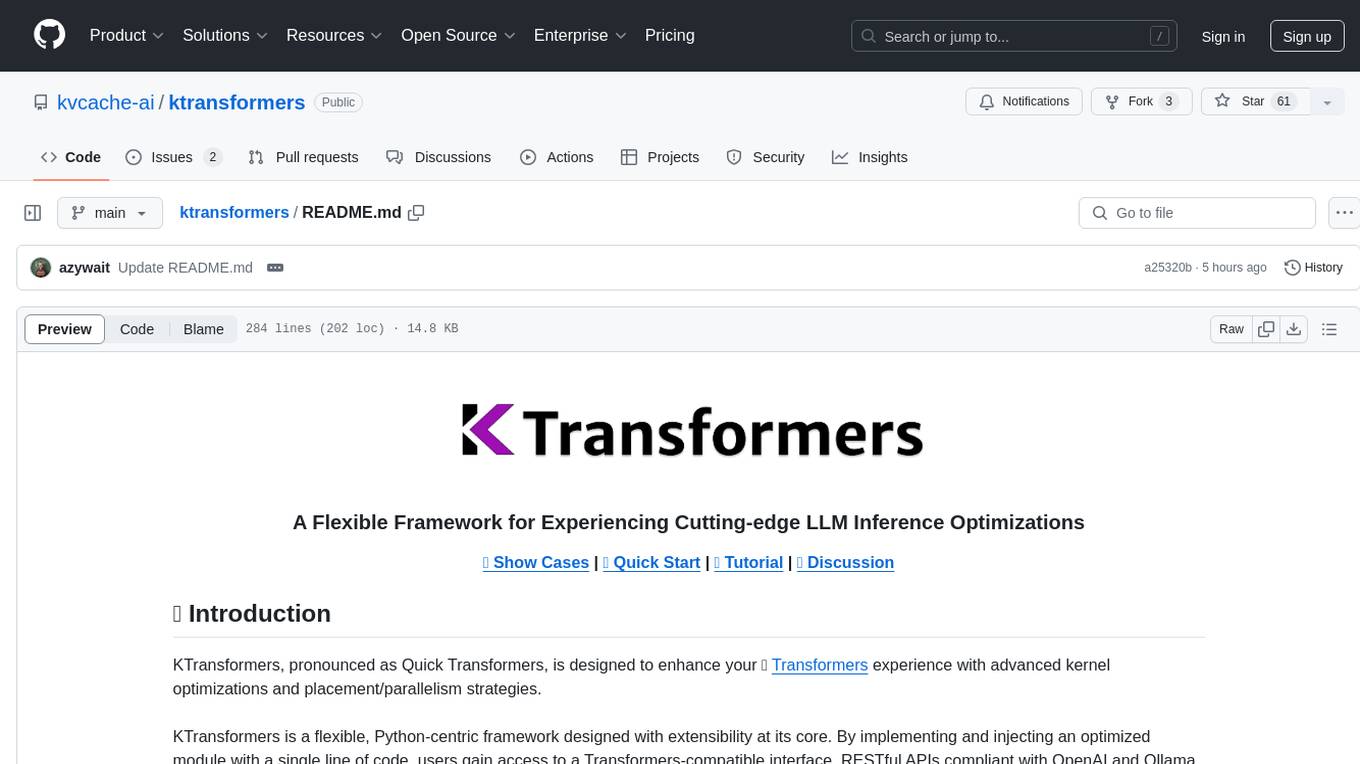
ktransformers
KTransformers is a flexible Python-centric framework designed to enhance the user's experience with advanced kernel optimizations and placement/parallelism strategies for Transformers. It provides a Transformers-compatible interface, RESTful APIs compliant with OpenAI and Ollama, and a simplified ChatGPT-like web UI. The framework aims to serve as a platform for experimenting with innovative LLM inference optimizations, focusing on local deployments constrained by limited resources and supporting heterogeneous computing opportunities like GPU/CPU offloading of quantized models.
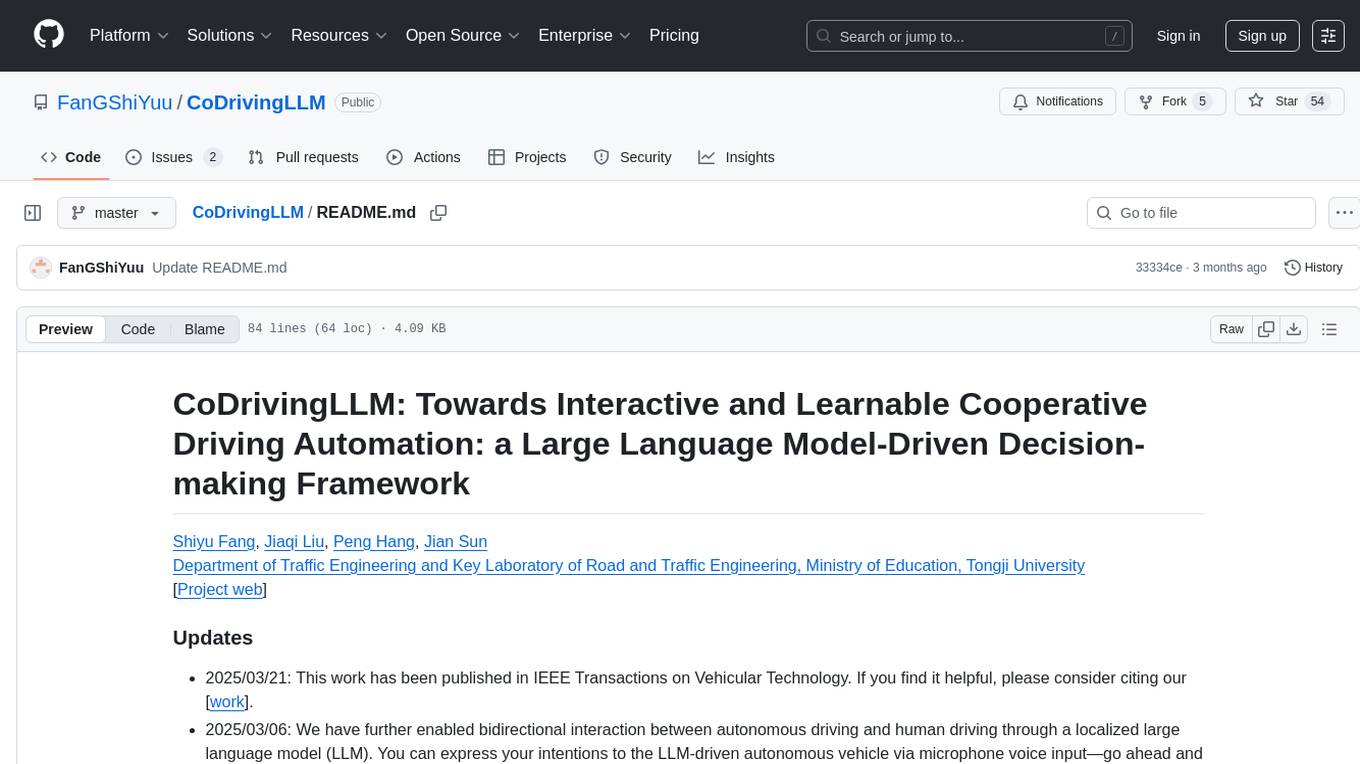
CoDrivingLLM
CoDrivingLLM is a machine learning model for predicting driving behavior based on sensor data collected from vehicles. It utilizes a Long Short-Term Memory (LSTM) neural network to analyze patterns in the data and make predictions about future driving actions. The model is trained on a large dataset of driving scenarios and can be used to improve driver assistance systems, enhance road safety, and optimize vehicle performance. CoDrivingLLM is designed to be easily integrated into existing automotive systems and can provide real-time feedback to drivers to help them make safer and more efficient driving decisions.
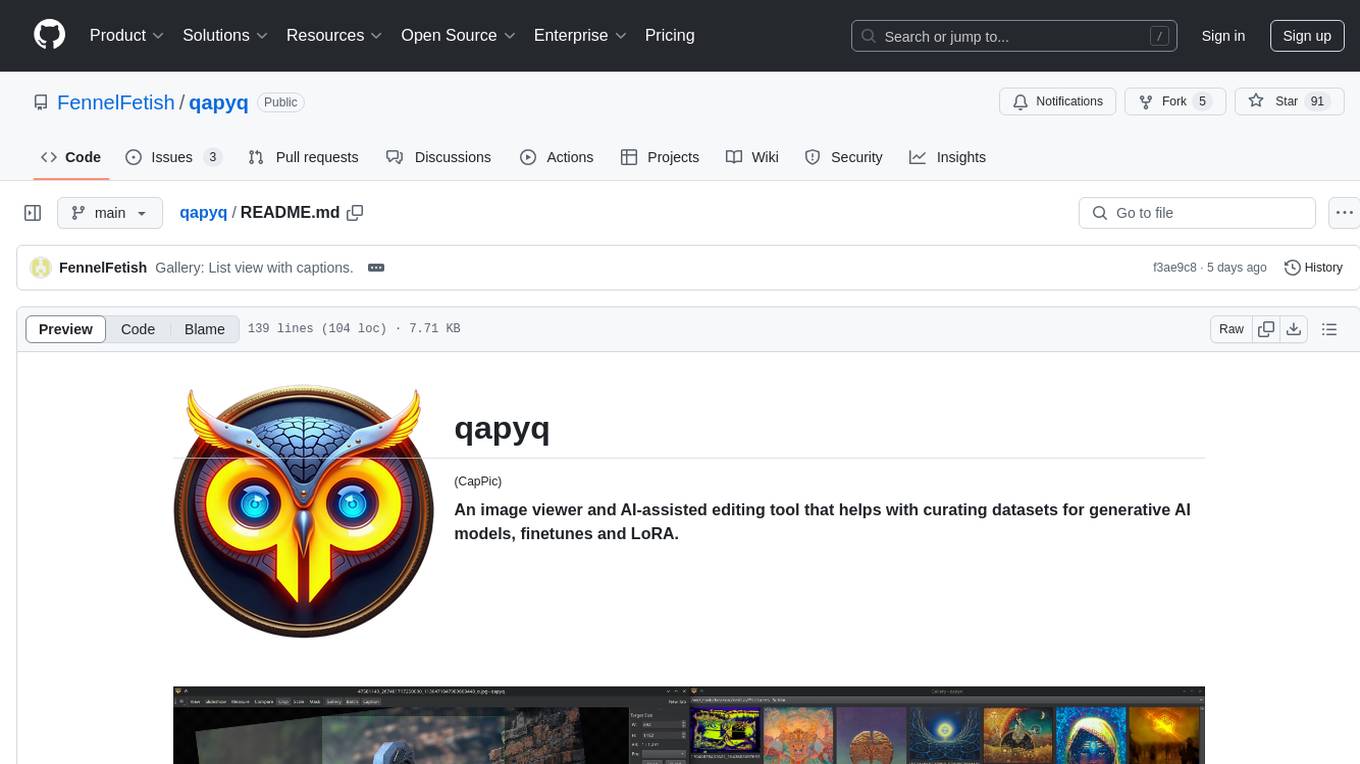
qapyq
qapyq is an image viewer and AI-assisted editing tool designed to help curate datasets for generative AI models. It offers features such as image viewing, editing, captioning, batch processing, and AI assistance. Users can perform tasks like cropping, scaling, editing masks, tagging, and applying sorting and filtering rules. The tool supports state-of-the-art captioning and masking models, with options for model settings, GPU acceleration, and quantization. qapyq aims to streamline the process of preparing images for training AI models by providing a user-friendly interface and advanced functionalities.
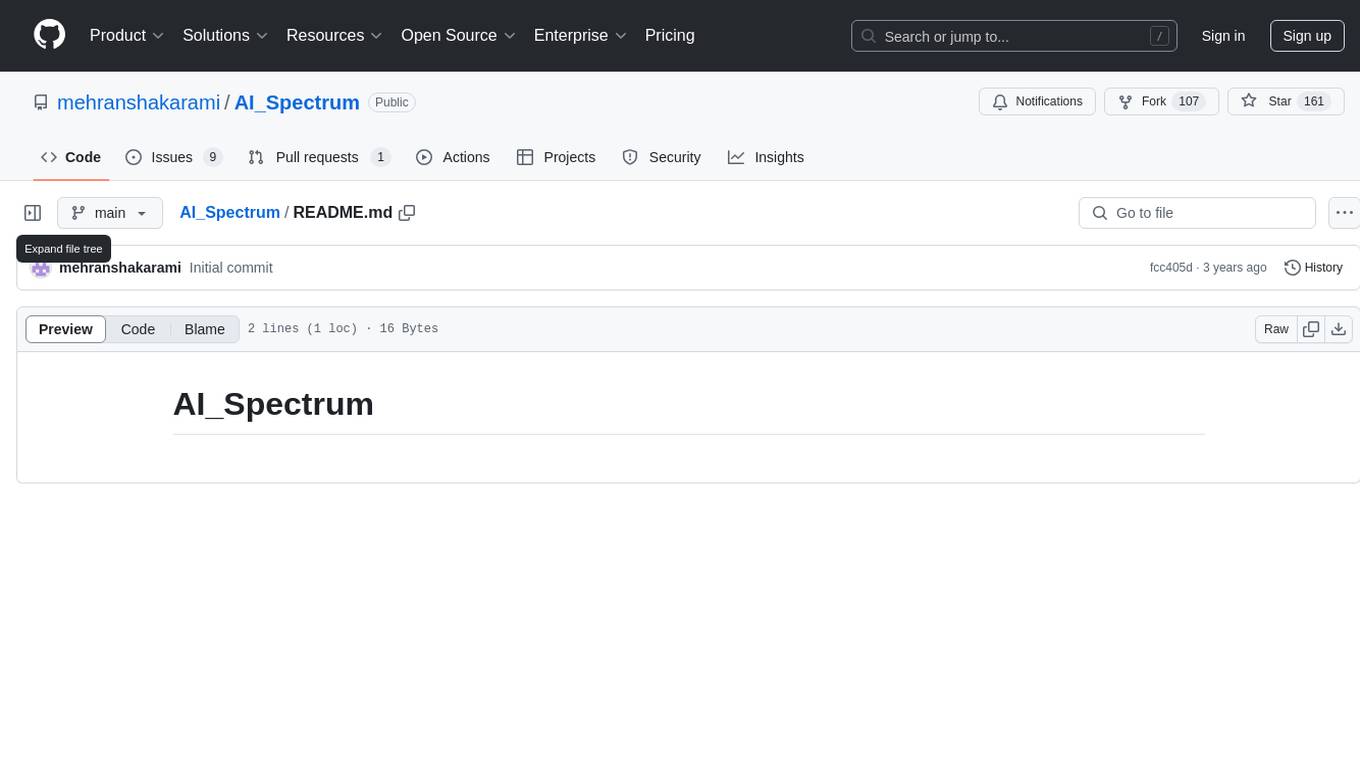
AI_Spectrum
AI_Spectrum is a versatile machine learning library that provides a wide range of tools and algorithms for building and deploying AI models. It offers a user-friendly interface for data preprocessing, model training, and evaluation. With AI_Spectrum, users can easily experiment with different machine learning techniques and optimize their models for various tasks. The library is designed to be flexible and scalable, making it suitable for both beginners and experienced data scientists.
For similar tasks

ai-edge-quantizer
AI Edge Quantizer is a tool designed for advanced developers to quantize converted LiteRT models. It aims to optimize performance on resource-demanding models by providing quantization recipes for edge device deployment. The tool supports dynamic quantization, weight-only quantization, and static quantization methods, allowing users to customize the quantization process for different hardware deployments. Users can specify quantization recipes to apply to source models, resulting in quantized LiteRT models ready for deployment. The tool also includes advanced features such as selective quantization and mixed precision schemes for fine-tuning quantization recipes.
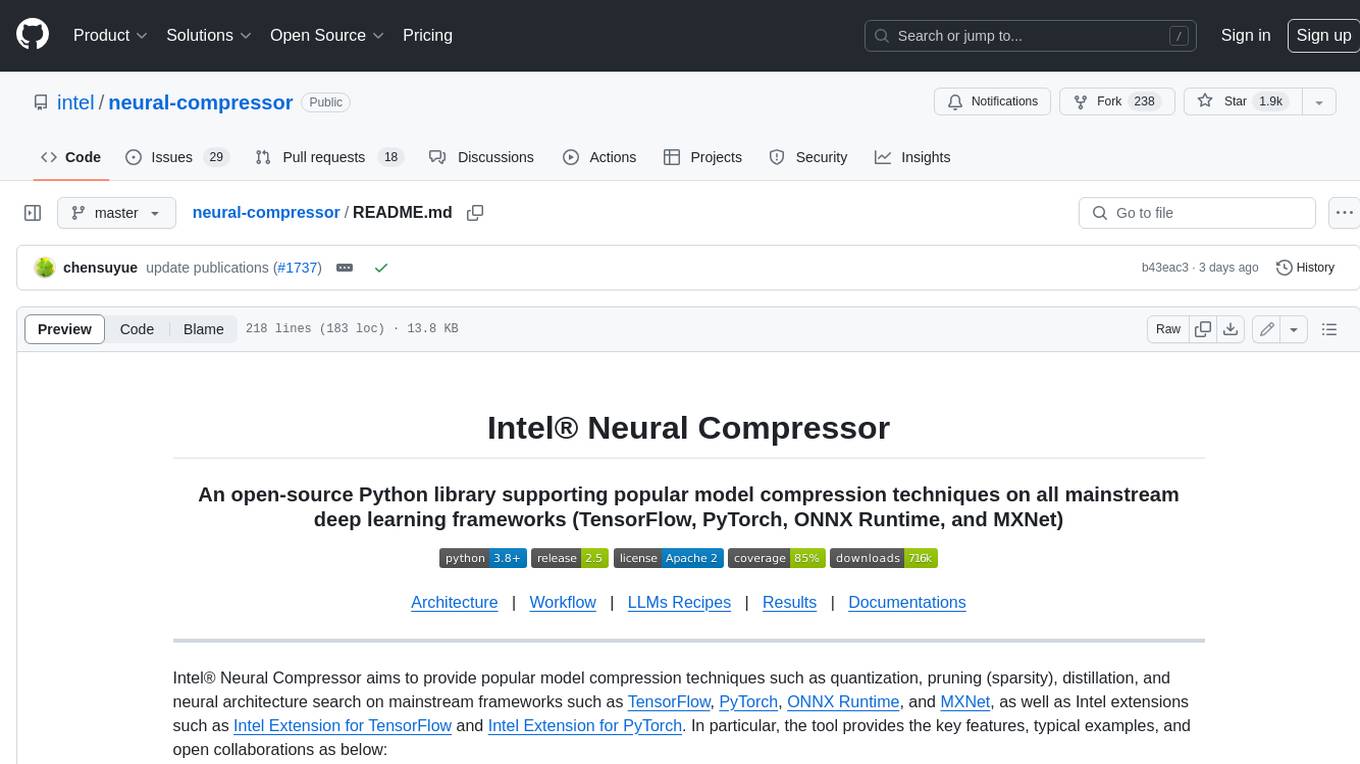
neural-compressor
Intel® Neural Compressor is an open-source Python library that supports popular model compression techniques such as quantization, pruning (sparsity), distillation, and neural architecture search on mainstream frameworks such as TensorFlow, PyTorch, ONNX Runtime, and MXNet. It provides key features, typical examples, and open collaborations, including support for a wide range of Intel hardware, validation of popular LLMs, and collaboration with cloud marketplaces, software platforms, and open AI ecosystems.
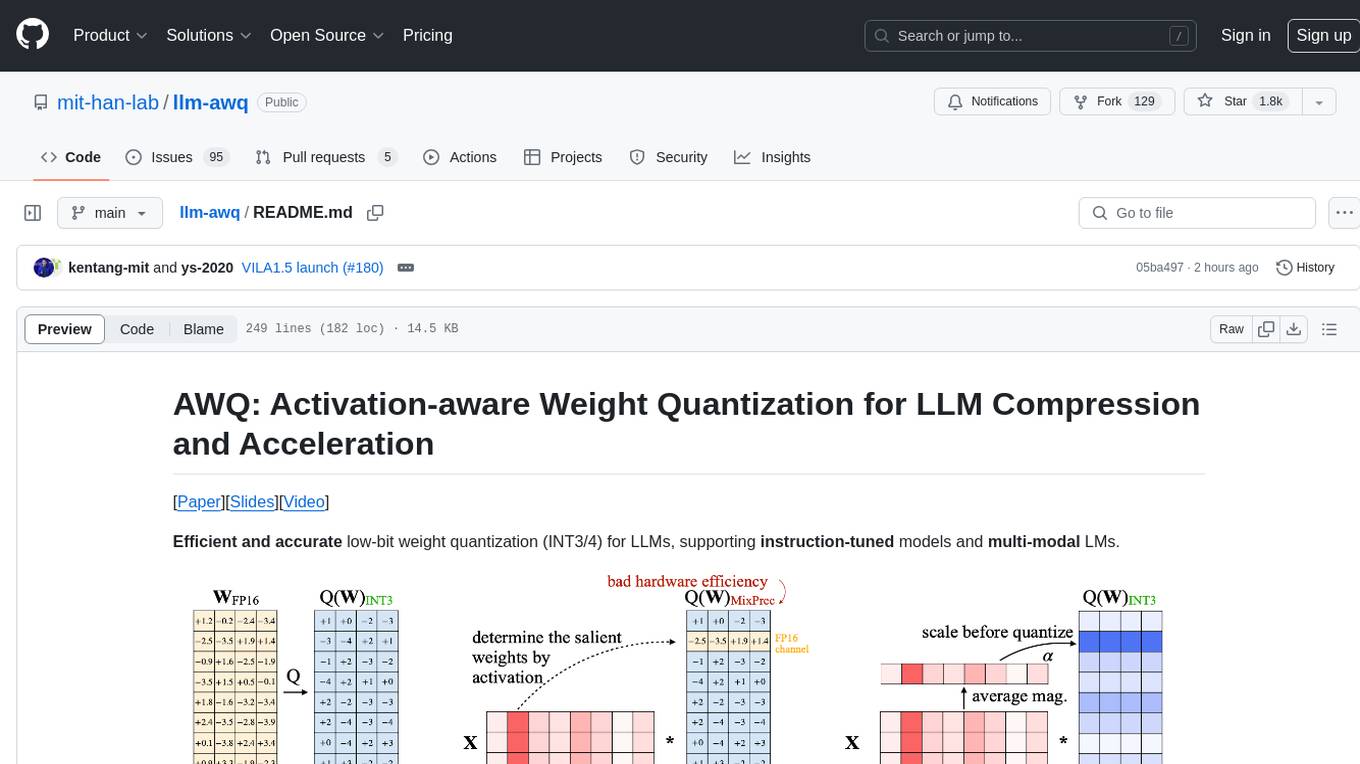
llm-awq
AWQ (Activation-aware Weight Quantization) is a tool designed for efficient and accurate low-bit weight quantization (INT3/4) for Large Language Models (LLMs). It supports instruction-tuned models and multi-modal LMs, providing features such as AWQ search for accurate quantization, pre-computed AWQ model zoo for various LLMs, memory-efficient 4-bit linear in PyTorch, and efficient CUDA kernel implementation for fast inference. The tool enables users to run large models on resource-constrained edge platforms, delivering more efficient responses with LLM/VLM chatbots through 4-bit inference.
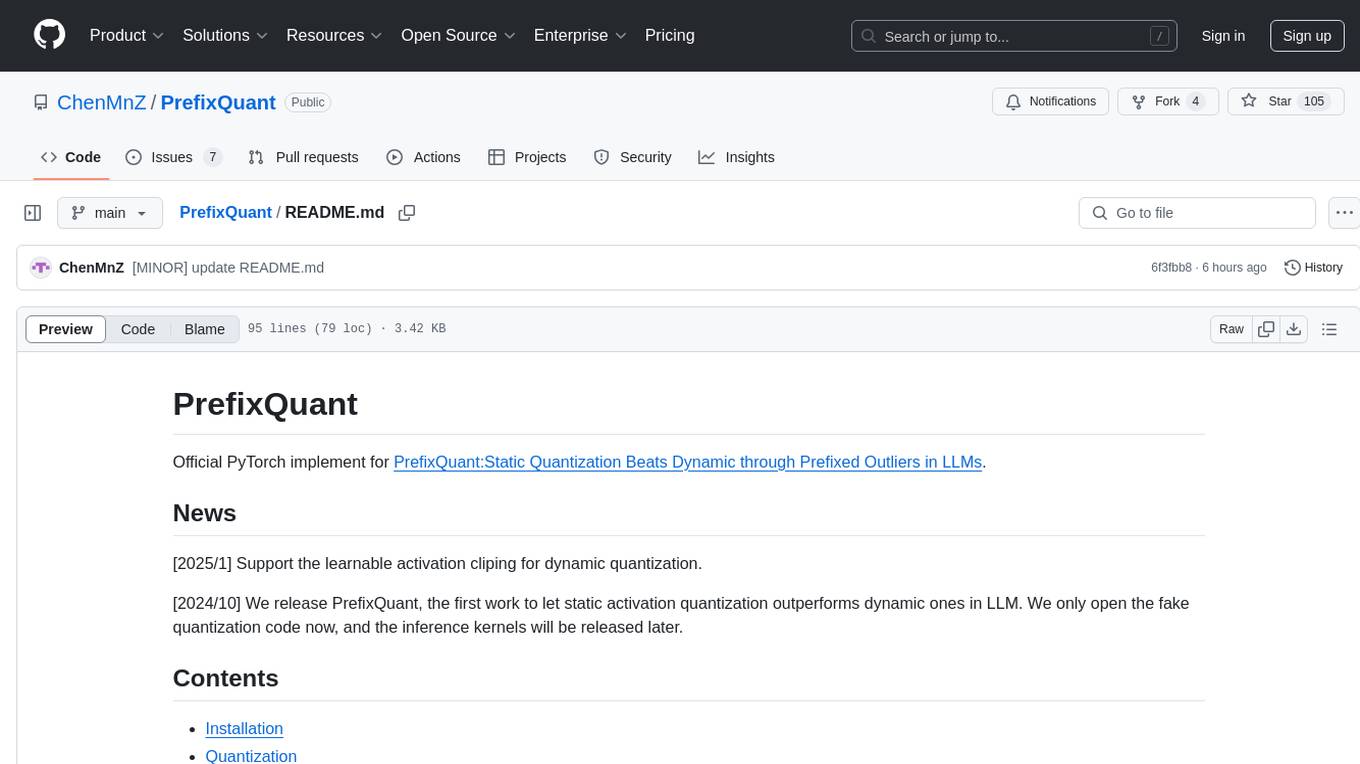
PrefixQuant
PrefixQuant is an official PyTorch implementation for static quantization that outperforms dynamic quantization in Large Language Models (LLMs) by utilizing prefixed outliers. The tool provides functionalities for quantization, inference, and visualization of activation distributions. Users can fine-tune quantization settings and evaluate pre-quantized models for tasks like PIQA, ARC, Hellaswag, and Winogrande. The approach aims to improve performance and efficiency in LLMs through innovative quantization techniques.
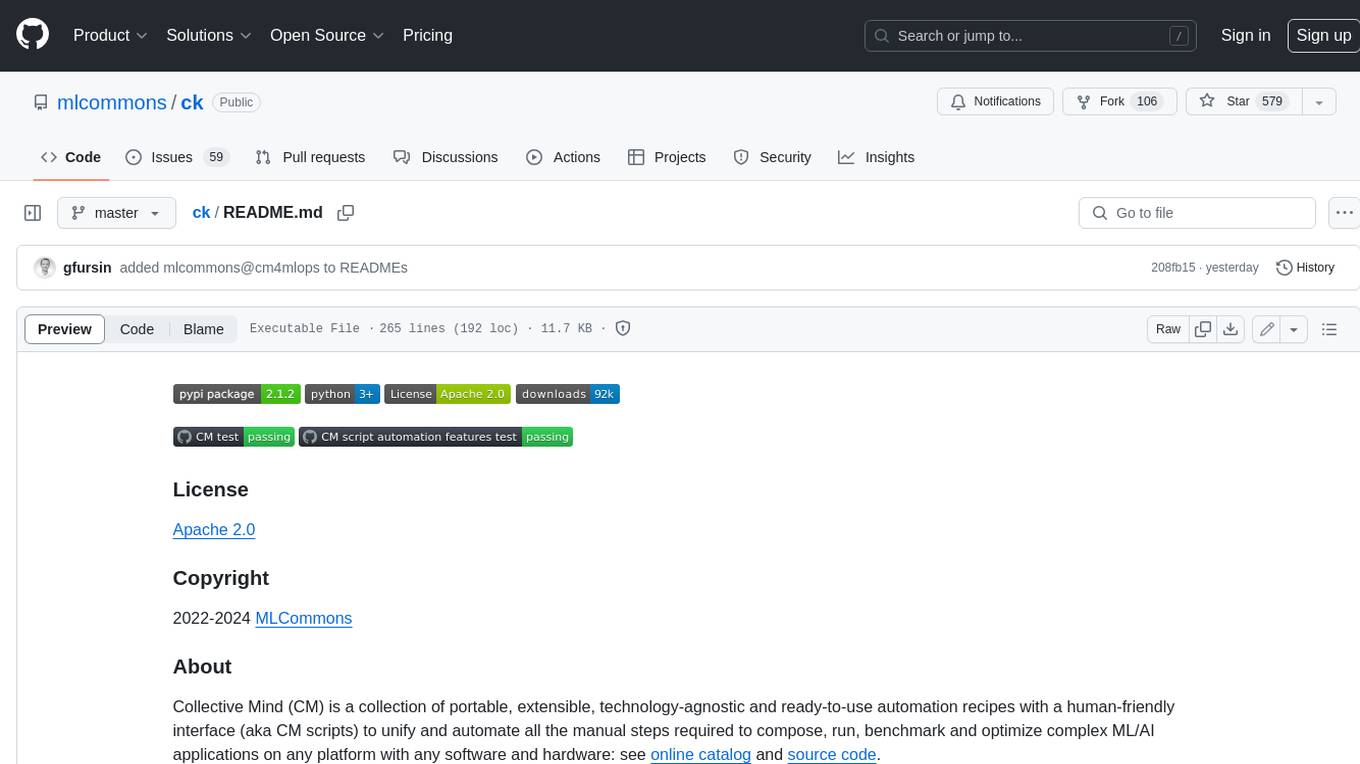
ck
Collective Mind (CM) is a collection of portable, extensible, technology-agnostic and ready-to-use automation recipes with a human-friendly interface (aka CM scripts) to unify and automate all the manual steps required to compose, run, benchmark and optimize complex ML/AI applications on any platform with any software and hardware: see online catalog and source code. CM scripts require Python 3.7+ with minimal dependencies and are continuously extended by the community and MLCommons members to run natively on Ubuntu, MacOS, Windows, RHEL, Debian, Amazon Linux and any other operating system, in a cloud or inside automatically generated containers while keeping backward compatibility - please don't hesitate to report encountered issues here and contact us via public Discord Server to help this collaborative engineering effort! CM scripts were originally developed based on the following requirements from the MLCommons members to help them automatically compose and optimize complex MLPerf benchmarks, applications and systems across diverse and continuously changing models, data sets, software and hardware from Nvidia, Intel, AMD, Google, Qualcomm, Amazon and other vendors: * must work out of the box with the default options and without the need to edit some paths, environment variables and configuration files; * must be non-intrusive, easy to debug and must reuse existing user scripts and automation tools (such as cmake, make, ML workflows, python poetry and containers) rather than substituting them; * must have a very simple and human-friendly command line with a Python API and minimal dependencies; * must require minimal or zero learning curve by using plain Python, native scripts, environment variables and simple JSON/YAML descriptions instead of inventing new workflow languages; * must have the same interface to run all automations natively, in a cloud or inside containers. CM scripts were successfully validated by MLCommons to modularize MLPerf inference benchmarks and help the community automate more than 95% of all performance and power submissions in the v3.1 round across more than 120 system configurations (models, frameworks, hardware) while reducing development and maintenance costs.
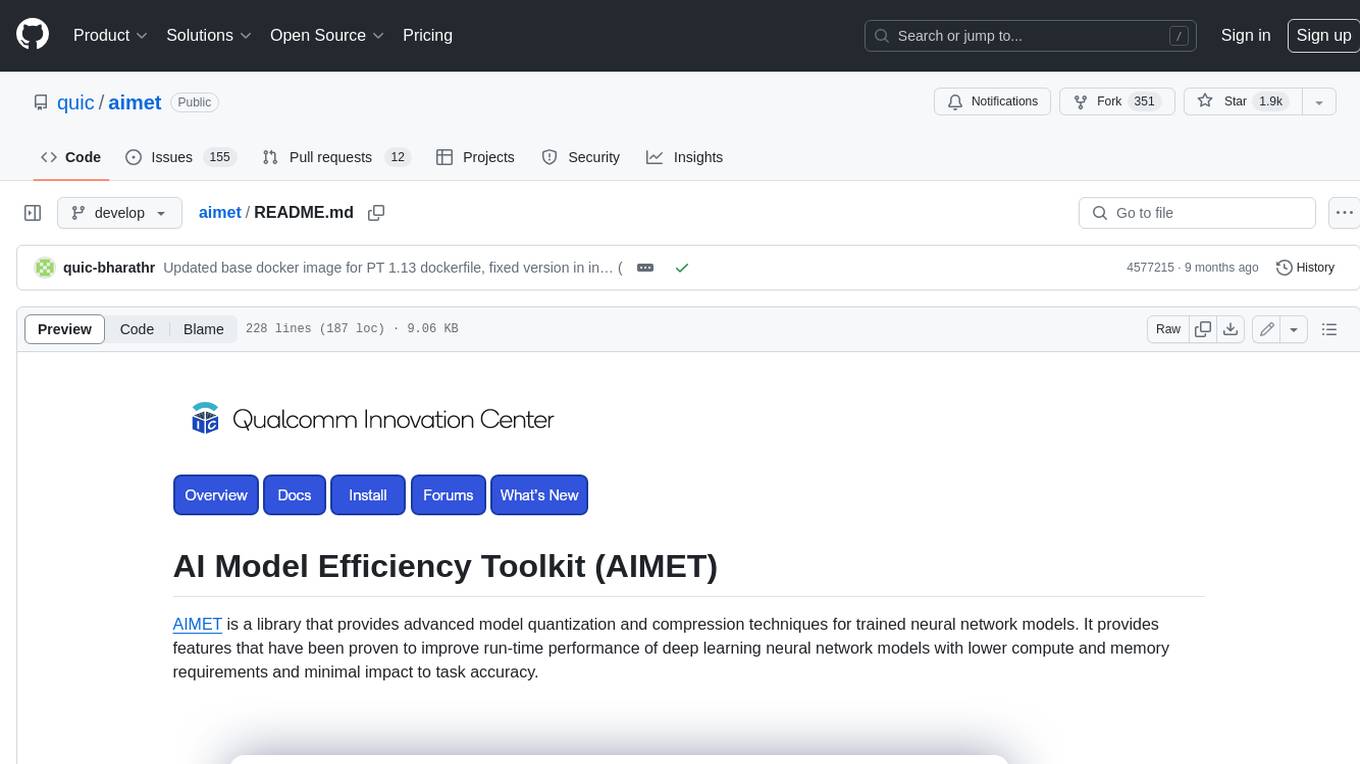
aimet
AIMET is a library that provides advanced model quantization and compression techniques for trained neural network models. It provides features that have been proven to improve run-time performance of deep learning neural network models with lower compute and memory requirements and minimal impact to task accuracy. AIMET is designed to work with PyTorch, TensorFlow and ONNX models. We also host the AIMET Model Zoo - a collection of popular neural network models optimized for 8-bit inference. We also provide recipes for users to quantize floating point models using AIMET.
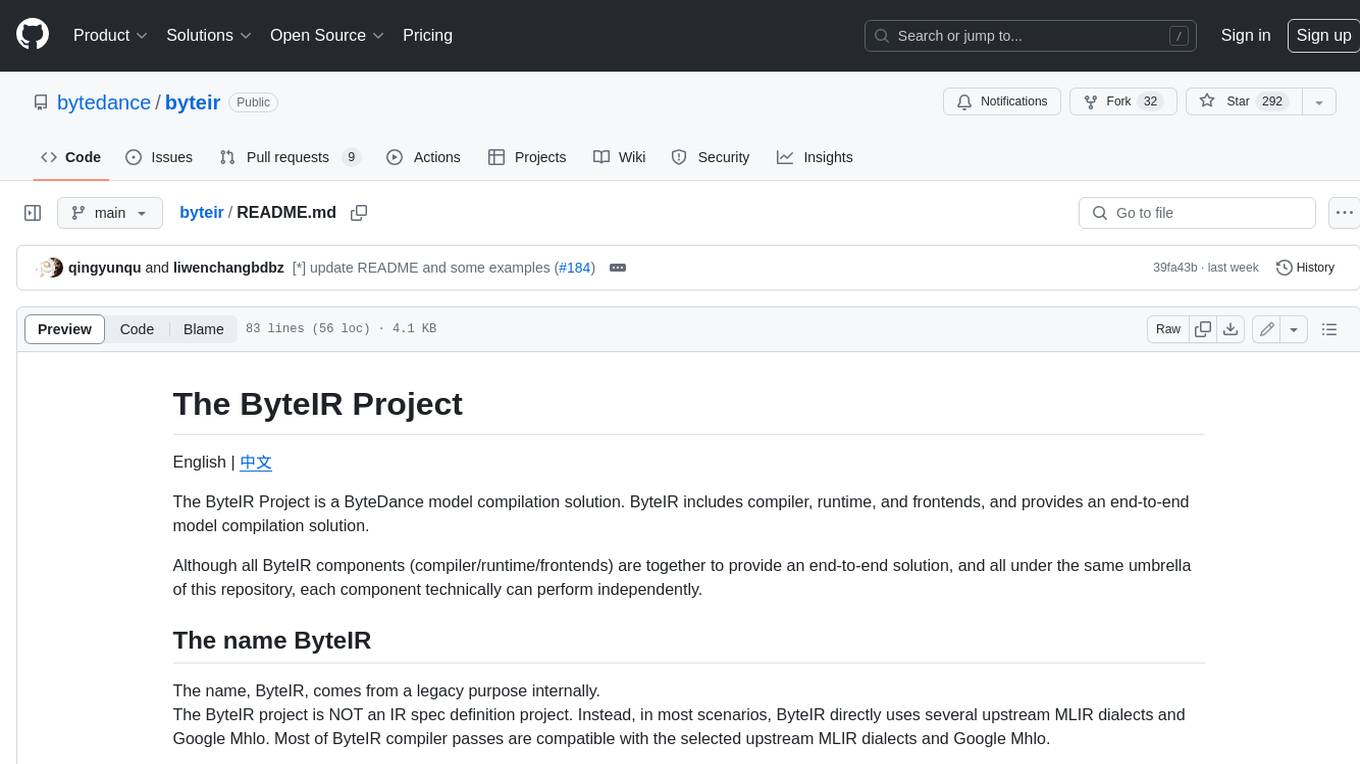
byteir
The ByteIR Project is a ByteDance model compilation solution. ByteIR includes compiler, runtime, and frontends, and provides an end-to-end model compilation solution. Although all ByteIR components (compiler/runtime/frontends) are together to provide an end-to-end solution, and all under the same umbrella of this repository, each component technically can perform independently. The name, ByteIR, comes from a legacy purpose internally. The ByteIR project is NOT an IR spec definition project. Instead, in most scenarios, ByteIR directly uses several upstream MLIR dialects and Google Mhlo. Most of ByteIR compiler passes are compatible with the selected upstream MLIR dialects and Google Mhlo.
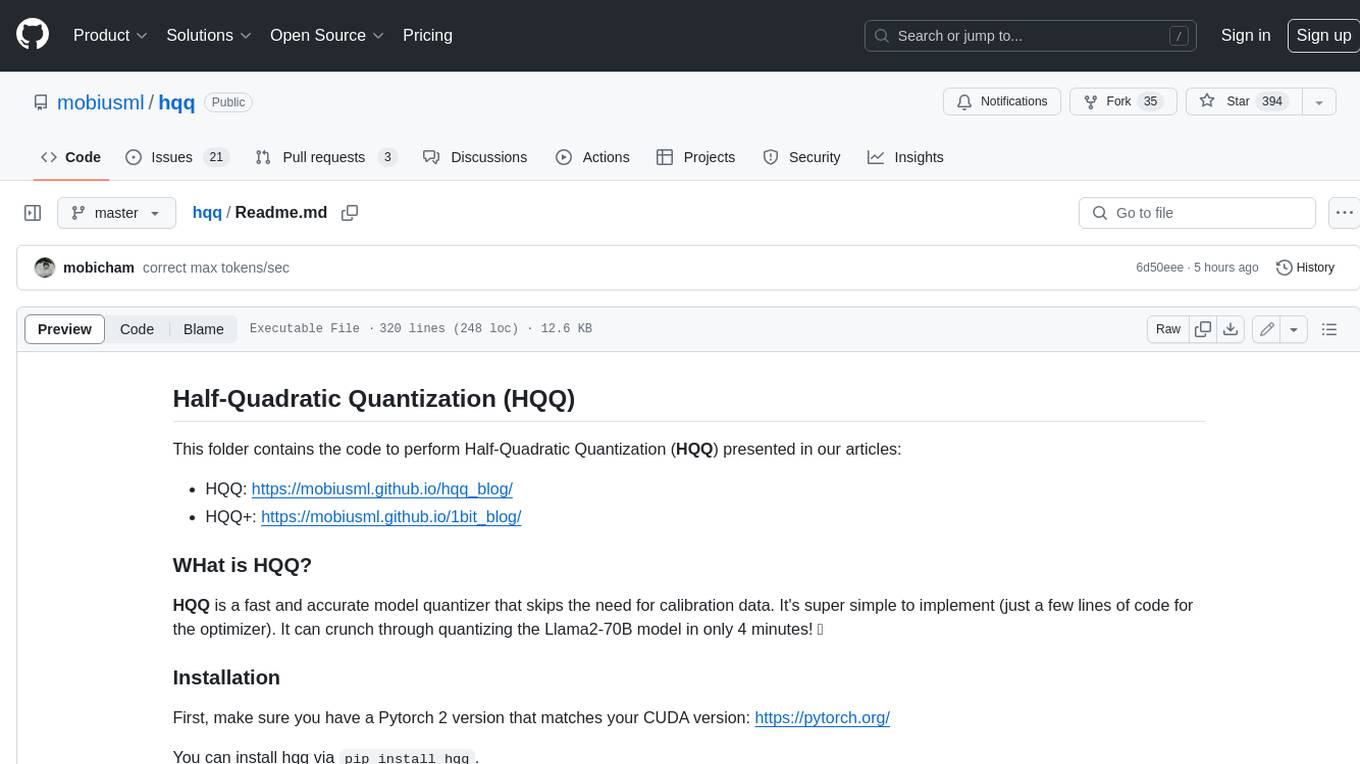
hqq
HQQ is a fast and accurate model quantizer that skips the need for calibration data. It's super simple to implement (just a few lines of code for the optimizer). It can crunch through quantizing the Llama2-70B model in only 4 minutes! 🚀
For similar jobs

weave
Weave is a toolkit for developing Generative AI applications, built by Weights & Biases. With Weave, you can log and debug language model inputs, outputs, and traces; build rigorous, apples-to-apples evaluations for language model use cases; and organize all the information generated across the LLM workflow, from experimentation to evaluations to production. Weave aims to bring rigor, best-practices, and composability to the inherently experimental process of developing Generative AI software, without introducing cognitive overhead.

LLMStack
LLMStack is a no-code platform for building generative AI agents, workflows, and chatbots. It allows users to connect their own data, internal tools, and GPT-powered models without any coding experience. LLMStack can be deployed to the cloud or on-premise and can be accessed via HTTP API or triggered from Slack or Discord.

VisionCraft
The VisionCraft API is a free API for using over 100 different AI models. From images to sound.

kaito
Kaito is an operator that automates the AI/ML inference model deployment in a Kubernetes cluster. It manages large model files using container images, avoids tuning deployment parameters to fit GPU hardware by providing preset configurations, auto-provisions GPU nodes based on model requirements, and hosts large model images in the public Microsoft Container Registry (MCR) if the license allows. Using Kaito, the workflow of onboarding large AI inference models in Kubernetes is largely simplified.

PyRIT
PyRIT is an open access automation framework designed to empower security professionals and ML engineers to red team foundation models and their applications. It automates AI Red Teaming tasks to allow operators to focus on more complicated and time-consuming tasks and can also identify security harms such as misuse (e.g., malware generation, jailbreaking), and privacy harms (e.g., identity theft). The goal is to allow researchers to have a baseline of how well their model and entire inference pipeline is doing against different harm categories and to be able to compare that baseline to future iterations of their model. This allows them to have empirical data on how well their model is doing today, and detect any degradation of performance based on future improvements.

tabby
Tabby is a self-hosted AI coding assistant, offering an open-source and on-premises alternative to GitHub Copilot. It boasts several key features: * Self-contained, with no need for a DBMS or cloud service. * OpenAPI interface, easy to integrate with existing infrastructure (e.g Cloud IDE). * Supports consumer-grade GPUs.

spear
SPEAR (Simulator for Photorealistic Embodied AI Research) is a powerful tool for training embodied agents. It features 300 unique virtual indoor environments with 2,566 unique rooms and 17,234 unique objects that can be manipulated individually. Each environment is designed by a professional artist and features detailed geometry, photorealistic materials, and a unique floor plan and object layout. SPEAR is implemented as Unreal Engine assets and provides an OpenAI Gym interface for interacting with the environments via Python.

Magick
Magick is a groundbreaking visual AIDE (Artificial Intelligence Development Environment) for no-code data pipelines and multimodal agents. Magick can connect to other services and comes with nodes and templates well-suited for intelligent agents, chatbots, complex reasoning systems and realistic characters.
